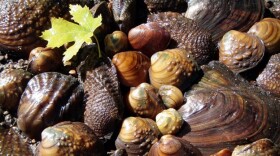Gardening in the Northwoods can be challenging. Long winters, short summers, and our many whitetail deer friends all conspire against us. In recent years, we have one more pest to deal with, the Japanese beetle.
You will quickly recognize Japanese beetles, Popillia japonica, because of their iridescent color. They are about ½ inch in length with metallic blue-green heads and copper-colored backs.
They are an exotic invasive, originating from Japan. They have been in the United States for more than 100 years. Most entomologists agree that the beetles entered the country as grubs in soil on Japanese iris roots. When I lived in Virginia in the late 1990s, they were a common pest and have since made their way to Wisconsin. They are relatively new to the Northwoods. A few years ago, when I found them in my garden, our campus insect specialist, PJ Liesch (the Wisconsin Bug Guy - Director of the UW-Madison Insect Diagnostic Lab) said he was surprised they made it this far north so quickly. I call them an exotic invasive due to their foreign origin, but the simple reality is they are here to stay. They are now part of our ecosystem.
One of the problems with the Japanese beetle is they feed so many different plants. They are classified as a pest to hundreds of different species. They are one of the major insect pests in the Eastern and Midwestern United States, causing significant damage to crops each year. In my yard, I find them on my raspberries, apple trees, and tomato plants. Their leaf chewing feeding pattern leaves a lacy skeleton across the leaf. Funny thing is I never see them on the thistles or burning nettles!
What can we do to combat this unwanted visitor?
- Hand Pick: Mix a squirt of dish soap with a cup of water in a cup or small bowl. Brush the beetle or shake the leaf, and it will fall into the water and drown. The insects have a natural defense to fall to the ground when disturbed, so holding your cup under the beetle is a good strategy. In the heat of the day, the beetles may fly away rather than dropping to the ground. You can also use a drop cloth under the plants, shake the beetles onto the cloth, then dump them into soapy water.
- Row Covers: Protect your plants from Japanese beetles with row covers during the 6- to 8-week feeding period in July and August. I will try this with my raspberries next year. This could be an effective strategy with strawberries as well. You will need to keep the screen covers open when plants flower to assure pollination.
- Insecticides: If you wish to spray or dust with insecticides, make you read and understand the labeled instructions that correspond to your insecticide of choice. The problem with many insecticides is they can be quite general and kill many different types of insects, including pollinators. It is especially important to avoid using insecticides when your plants are flowering. If you are considering applying insecticides, I would encourage you to look at the University of Wisconsin Pesticide Applicator Training Program. This program provides educational materials for the purpose of pesticide applicator certification in Wisconsin. Even if you have not intension of taking the test to become a certified applicator, you will learn a lot by reading the workbook materials.
- Japanese Beetle Traps: These traps use a pheromone attractant to capture the beetles, but sometimes attract beetles a little too well. Don’t place one near your garden or you’ll be pulling beetles in from all over town and end up with a worse problem. I thought about putting the traps by my wife’s flowers to steer the beetles away from my raspberries. How do you think that plan will work out?
- Use parasitic nematodes in lawns and garden beds for grub control; however, this will not impact the grubs on nearby properties.
These are just a few strategies to deal with the Japanese beetle. As long as I am able to pick some raspberries and harvest some vegetables from my garden, I will tolerate some Japanese beetles. Remember they are an exotic invasive, but they are here to stay.
For more information on Japanese beetles, look here:
https://vegento.russell.wisc.edu/pests/japanese-beetle/









